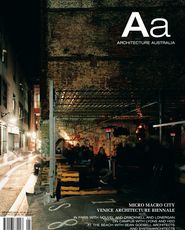Sandra Kaji-O’Grady kicks off Architecture Australia’s series about the value of what we do with her speculations on what architecture might mean to others. What are the signs that the rest of the community also thinks architecture matters?
Architecture matters to all of us who practise or preach it – not only is it personally crucial to our livelihood and identity, we’re schooled in the belief that without (modern) architecture, the world will fall into revolution. But how do we know that it matters to others? What evidence do we have? Below are some clues:
1. It is the subject of close regulation and control.
The best evidence of architecture’s power to call into question the status quo are the efforts taken by governing bodies including councils, the protectors of heritage and neighbours to control it. Some rules are concerned with safety, health and amenity but others, more interestingly, police taste and stylistic change.
When the profile of a balustrade, the colour and location of a garage door or the pitch of a roof are no longer subjects of contestation, then we can conclude that architecture no longer matters.
2. It has symbolic potency and is a powerful political tool. This is understood by a disparate group including branding gurus, so-called “terrorists”, provincial towns vying for a Guggenheim franchise, the prime ministers of France with their grand projets and property lenders and developers. These people recognize that architecture can convey national pride, investor security, institutional organization and vision, and commitment to a people or certain values.
3. Architecture adds value. Real estate agents, property developers and vendors are confident that terms such as “architect designed”, the ambiguous “architect inspired” (for when the architect was sacked or quit before construction began), and even specifically named architectural authorship will increase the value of a property.
4. Public discussion. So architecture lags behind new cinematic releases, books and music in print exposure, but it does get the occasional feature piece and, in some cities, a regular, albeit weekday, column. And it gets a much stronger showing in the monthlies. Surely it can’t be only architects purchasing professional journals, interior design magazines and “lifestyle” crossovers such as Pol Oxygen and Wallpaper?
5. Hollywood. Architects are disproportionately represented as characters in film. Doctors, forensic scientists and detectives are also over-represented but that is because their occupation bears some relationship to the plot. Architects, by contrast, feature in everything from airplane disasters, science fiction and family drama to romantic comedy. Sure, an architect gives set designers some great opportunities and, in the case of Keanu Reeves’s architect in the recently released The Lake House, provides an excuse for the director to linger longer on Chicago’s buildings than might otherwise be plausible. But what is notable is that architect characters carry a moral imperative, a legacy perhaps of The Fountainhead. Architects, if we are to believe Hollywood, are naive, principled and photogenic optimists – they are utopians and as such are central to the drama of contemporary culture.
6. Metaphor. As Mark Wigley made so clear in his book The Architecture of Deconstruction: Derrida’s Haunt (1993), philosophy depends on architectural metaphors and – rather than these being incidental, metaphors of foundation, structure, dwelling, ruin, construction, inside and outside, et cetera – they determine what can be thought and said. Not only does philosophy need architecture and the metaphor that can be drawn from it, imagine these words by T. S. Eliot without architecture: “Footfalls echo in the memory/Down the passage which we did not take/Towards the door we never opened/Into the rose-garden.”
7. Happiness. In The Architecture of Happiness, Alain de Botton is convinced that good architecture (seemingly that which has bare timber floorboards) gives dignity and a sense of belonging, community and continuity to its occupants. Curiously, given his previous text Status Anxiety, de Botton fails to notice that great architecture – especially in the domestic realm – can make aspiring occupants (a much larger group than privileged inhabitants) feel really, really sad.
For the first few months of living in Sydney I was utterly content with my rented flat with its harbour “cameos” and the distant sound of water lapping at the edges of the garden. This satisfaction was destroyed by a visit to the flat of an architect of my own generation who not only had beach views from all windows, he had architecture – his own. His flat bore the mark of architectural intelligence and a sensual abstraction, mine the frugality of my landlady. The harbour receded and all I could now see was the cheap carpet and cream walls – the architectural equivalent of order envy. In the First World, mortgages and architectural aspirations keep many people turning up for work each day. That architecture can elicit longing as well as pride is evidence, not only of how much it matters, but of the weight of responsibility borne by architects.
DR SANDRA KAJI-O’GRADY IS ASSOCIATE PROFESSOR AND HEAD OF ARCHITECTURE AT THE UNIVERSITY OF TECHNOLOGY, SYDNEY.















